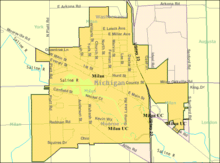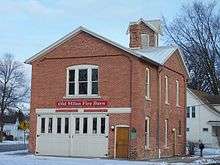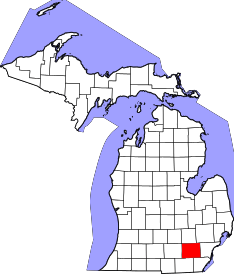Milan, Michigan
| Milan, Michigan | |
|---|---|
| City | |
 Location of Milan, Michigan | |
| Coordinates: 42°5′9″N 83°41′4″W / 42.08583°N 83.68444°W | |
| Country | United States |
| State | Michigan |
| Counties | Monroe, Washtenaw |
| City Of Milan | 1968 |
| Government | |
| • Type | Mayor/Council |
| • Mayor | Michael Armitage |
| • Mayor Pro-Tem | Martha Churchill |
| Area[1] | |
| • Total | 3.40 sq mi (8.81 km2) |
| • Land | 3.32 sq mi (8.60 km2) |
| • Water | 0.08 sq mi (0.21 km2) |
| Elevation | 702 ft (214 m) |
| Population (2010)[2] | |
| • Total | 5,836 |
| • Estimate (2012[3]) | 5,867 |
| • Density | 1,757.8/sq mi (678.7/km2) |
| Time zone | Eastern (EST) (UTC-5) |
| • Summer (DST) | EDT (UTC-4) |
| ZIP code | 48160 |
| Area code(s) | 734 |
| FIPS code | 26-53920[4] |
| GNIS feature ID | 0632302[5] |
| Website |
milanmich |
Milan ![]() i/ˈmaɪlən/ is a city in Monroe and Washtenaw counties in the U.S. state of Michigan. The population was 5,836 at the 2010 census. About 60% of the city's area and 75% of its residents are located on the Washtenaw County side adjacent to York Charter Township in Washtenaw County; while 40% percent of the city's area and 25% of its residents are located on the Monroe County side adjacent to Milan Township.
i/ˈmaɪlən/ is a city in Monroe and Washtenaw counties in the U.S. state of Michigan. The population was 5,836 at the 2010 census. About 60% of the city's area and 75% of its residents are located on the Washtenaw County side adjacent to York Charter Township in Washtenaw County; while 40% percent of the city's area and 25% of its residents are located on the Monroe County side adjacent to Milan Township.
History
The city was founded in 1831 by John Marvin, Bethuel Hack, and Harmon Allen. Hack was the first postmaster, and he named the community "Farmer" since everyone there was a farmer. Drug store owner Henry Tolan took over as postmaster and renamed the community "Tolanville" after himself. Next, David Woodard became the post master, with the post office in his flour mill. He renamed the community "Woodard's Mills." The postmaster in Washington D.C. noticed the confusion caused by this swift change in names and decreed that it would henceforth be called "Milan" after the neighboring Milan Township. French settlers in the area named the township "Milan" because they once hoped to produce grapes and wine in the area, so the Italian city by that name seemed appropriate, given Italy's reputation for wine-making. The river going through Milan and Milan township is the Saline River, part of the River Raisin watershed. "River Raisin" refers to Raisin, the French word for grape. Small wild grapes were growing on the banks of the river, so early French settlers in the Monroe area hoped that this area would be wine country. Just southeast of Milan, along Plank road, is an old community by the name of "Grape" which is a reflection of this desire to create a wine producing area. Milan became a village in 1885. It continued as a village until 1967, when it was incorporated as a city.
Notable people
Walter F. Stimpson was a Milan farm boy who eventually held 74 US patents during his life, and was one of the founders of IBM—International Business Machines.
Stimpson was born in 1870 on a farm west of Mooreville. In 1892 he got his first patent, a mechanism to lower the wheels of a grain harvester. At that time he was a graduate of Cleary Business School and he was teaching school. That same year, he noticed a local grocer frustrated by the scales which were so complicated in figuring out the price of the product. Stimpson spent some time with the blacksmith tools at his father's farm, and tinkered on an old scale. He came up with a revolutionary idea for a "computing scale." Stimpson's ideas to improve scales made a tremendous impact on industry in the US and worldwide because business depends on accurately knowing how much is being bought or sold. He developed scales for large items such as farm scales, such as a wagon full of pumpkins, a cow, or a load of coal.[6] He built a Stimpson factory in Milan on Plank Road at Dexter Road, later the Ideal Foundry.[7] He worked on scales to weigh small items such as envelopes, for postage; candy; or diamonds. In about 1903, Stimpson built a fantastic and imposing brick hotel in downtown Milan, the Stimpson Hotel. The Italianate-style building was later known in Milan as the Danube Inn. It is no longer standing, having been destroyed by fire in 2011. Stimpson set up factories early in his career in Tecumseh, MI; Northville, MI; Detroit; and Elkhart, IN. He settled finally in Louisville, KY. One of Stimpson's Detroit companies eventually merged with a company involved with clocks and a company dealing in cash registers, called the Computing-Tabulating-Recording Company. That company later changed its name to International Business Machines or IBM. In later years, customers of Stimpson Scales, if they needed parts for their scales, contacted IBM as the successor corporation.[8] Stimpson was living in Louisville in 1941 when he died.[9] He left behind a widow and a large, modern factory making coffee grinders, meat slicers, and of course scales.
Geography

According to the United States Census Bureau, the city has a total area of 3.40 square miles (8.81 km2), of which, 3.32 square miles (8.60 km2) is land and 0.08 square miles (0.21 km2) is water.[1] Milan is located 16 miles (26 km) southeast of Ann Arbor and 37 miles (60 km) northwest of Toledo.
Demographics
| Historical population | |||
|---|---|---|---|
| Census | Pop. | %± | |
| 1880 | 320 | — | |
| 1890 | 917 | 186.6% | |
| 1900 | 1,141 | 24.4% | |
| 1910 | 1,355 | 18.8% | |
| 1920 | 1,557 | 14.9% | |
| 1930 | 1,947 | 25.0% | |
| 1940 | 2,340 | 20.2% | |
| 1950 | 2,768 | 18.3% | |
| 1960 | 3,616 | 30.6% | |
| 1970 | 3,997 | 10.5% | |
| 1980 | 4,182 | 4.6% | |
| 1990 | 4,040 | −3.4% | |
| 2000 | 4,775 | 18.2% | |
| 2010 | 5,836 | 22.2% | |
| Est. 2015 | 5,983 | [10] | 2.5% |
2010 census
As of the census[2] of 2010, there were 5,836 people, 2,308 households, and 1,532 families residing in the city. The population density was 1,757.8 inhabitants per square mile (678.7/km2). There were 2,487 housing units at an average density of 749.1 per square mile (289.2/km2). The racial makeup of the city was 92.3% White, 2.8% African American, 0.5% Native American, 0.9% Asian, 1.0% from other races, and 2.6% from two or more races. Hispanic or Latino of any race were 4.6% of the population.
There were 2,308 households of which 38.5% had children under the age of 18 living with them, 47.3% were married couples living together, 14.4% had a female householder with no husband present, 4.7% had a male householder with no wife present, and 33.6% were non-families. 27.8% of all households were made up of individuals and 8.9% had someone living alone who was 65 years of age or older. The average household size was 2.52 and the average family size was 3.10.
The median age in the city was 34.4 years. 28% of residents were under the age of 18; 8.5% were between the ages of 18 and 24; 31% were from 25 to 44; 22.9% were from 45 to 64; and 9.7% were 65 years of age or older. The gender makeup of the city was 48.2% male and 51.8% female.
2000 census
As of the census[4] of 2000, there were 4,775 people, 1,923 households, and 1,271 families residing in the city. The population density was 2,127.4 per square mile (823.1/km²). There were 1,999 housing units at an average density of 890.6 per square mile (344.6/km²). The racial makeup of the city was 94.30% White, 1.74% African American, 0.36% Native American, 0.69% Asian, 0.02% Pacific Islander, 1.72% from other races, and 1.17% from two or more races. Hispanic or Latino of any race were 3.50% of the population.
There were 1,923 households out of which 36.7% had children under the age of 18 living with them, 49.1% were married couples living together, 13.5% had a female householder with no husband present, and 33.9% were non-families. 28.0% of all households were made up of individuals and 10.1% had someone living alone who was 65 years of age or older. The average household size was 2.48 and the average family size was 3.04.
In the city the population was spread out with 27.6% under the age of 18, 8.7% from 18 to 24, 34.2% from 25 to 44, 19.1% from 45 to 64, and 10.5% who were 65 years of age or older. The median age was 33 years. For every 100 females there were 92.3 males. For every 100 females age 18 and over, there were 87.9 males.
The median income for a household in the city was $61,250. The per capita income for the city was $23,909. About 8.6% of the population were below the poverty line.
Communities in the immediate area
Mooreville
Mooreville is located about two miles west of Milan. It was founded in 1831 by William Moore; Moore purchased property in York Township in 1831 and created a home there for himself and his family. At one time Mooreville was a larger town than Milan, with a post office, flour mill, physician, cheese factory, and other amenities ahead of Milan's development. But in 1878 the Ann Arbor Railroad built a line through Milan, bypassing Mooreville; and in 1880 the Wabash Railroad did likewise. After that, Mooreville's population diminished, but it still has a cluster of homes there who identify themselves as residents of Mooreville. This community is a hamlet, never having attained the status of village.[12][13][14][15]
Prevalent architecture

Turn-of-the-century, two-story homes are prevalent. Close to downtown, many homes have barns which once housed the family horse and carriage; the barns now shelter the family car. About one-quarter of the homes in Milan were built before World War II, and 21 percent built between 1940 and 1959. A symbol of the architecture is Community House, a two-story grist mill Henry Ford purchased in 1935. Ford had an engine coil manufacturing plant in an area which is now a parking lot between the police station and city hall. He had a soybean processing plant next to the former flour mill (now used for public works). Ford probably had the idea to make paint from soybeans, but the Milan plant did not make paint, just soybean oil. Area residents can utilize the Community House for small gatherings and it now houses the City Recreation Department dance studio.
Despite the increase in development, Milan is still equated with country living. There are working farms with cows and horses scattered in the surrounding area. A workshop for hand-built wooden organs is housed on East Main inside the city, in a relocated barn tucked along the Saline River. The small town began to develop its industrial base in the 1960s. Until recently, a great deal of its tax base was from the Visteon facility (Ford Motor Co.) Downtown Milan boasts a place on the National Register of Historic Places with fine examples of Italianate, International, Art Modern, and other architectural styles. One corner features a fully restored Fire Barn once used as a library, jail and as village hall over the years. It now houses the Chamber of Commerce office and Milan Area Historical Society meeting place.
Part of Milan's present City Hall is the former Ford Power Plant used for the Village industries. Henry Ford built the power plant in 1937 when he dredged Ford Lake. He also used a former lumber yard garage as a factory to make engine ignition coils. Ford intended his factory to depend upon hydraulic power, which is why he built a very fine dam to power his plant. Unfortunately, the water power was inadequate, and his "Ford Industries" actually ran on steam engines depending on coal.
Government and infrastructure
The United States Postal Service operates the Milan Post Office.[16]
A Federal Bureau of Prisons prison, the Federal Correctional Institution, Milan (FCI), is in adjacent York Charter Township.[17] The prison is notable for the execution of Tony Chebatoris, the only person to receive the death penalty since Michigan became a state in 1837. He was convicted of robbing a bank in Midland, where someone died as a result of the botched bank heist. Chebatoris was hanged at the Milan prison at 5:08 a.m. on July 8, 1938. His body was taken to Stevens Funeral Home in Milan, where it was embalmed, placed in a casket, and buried at Marble Park Cemetery just west of Milan. His gravestone says: "“Tony” Chebatoris, 1900-1938".
Notable institutions
Milan is known regionally for its Automobile Drag racing venue, the Milan Dragway even though it is actually in London Township.
Milan's own museum is the Hack House, built in 1888 by Olive Friend. She got her money for the home by a corporate scam in New York, the "Electric Sugar Refining Machine" company. After she moved out of the house, her cousin Jim Hack occupied it for generations, so the house is known in the Milan area as the "Hack House."
Home to one of the oldest family owned and operated automobile dealerships in Michigan, Schultz Motors was established in 1945 and is currently operated by the third generation of Schultz family members. The original dealership building still stands as the current Fire Station.
Schultz Bottled Gas is the oldest continuously family-owned retail business in Milan and has been family owned and operated 1939-2015. The families that own Schultz Motors and Schultz Bottled Gas are entirely different and not related to each other.
Chase Bank in Milan is descended from the Milan State Savings Bank which was founded in 1911 at the same location, on Wabash Street, and has been operating continuously under various names up to the present time.
References
- 1 2 "US Gazetteer files 2010". United States Census Bureau. Retrieved 2012-11-25.
- 1 2 "American FactFinder". United States Census Bureau. Retrieved 2012-11-25.
- ↑ "Population Estimates". United States Census Bureau. Retrieved 2013-06-03.
- 1 2 "American FactFinder". United States Census Bureau. Retrieved 2008-01-31.
- ↑ "US Board on Geographic Names". United States Geological Survey. 2007-10-25. Retrieved 2008-01-31.
- ↑ Martha Churchill, Milan historian
- ↑ Warren R. Hale, "Way Back When" columns published in Milan News Leader
- ↑ The book, Images of America, Milan, by Martha A. Churchill
- ↑ Death certificate of Walter F. Stimpson
- ↑ "Annual Estimates of the Resident Population for Incorporated Places: April 1, 2010 to July 1, 2015". Retrieved July 2, 2016.
- ↑ "Census of Population and Housing". Census.gov. Retrieved June 4, 2015.
- ↑ Way Back When columns by Warren Hale in the Milan News Leader;
- ↑ atlas records of Washtenaw County;
- ↑ Register of Deeds, Washtenaw County;
- ↑ plat maps, Washtenaw County
- ↑ "Post Office Location - MILAN." United States Postal Service. Retrieved on May 18, 2010.
- ↑ "MINUTES OF A REGULAR MEETING OF THE MILAN CITY COUNCIL HELD ON DECEMBER 7, 2009 AT 7:30 P.M. IN THE COUNCIL CHAMBERS, MILAN CITY HALL, 147 WABASH STREET, MILAN, MICHIGAN, 48160." City of Milan. Minutes approved December 7, 2009. Retrieved on January 5, 2010. "The City has a ten year agreement through the General Services Administration (GSA) to provide utility services to the Federal Corrections Institute and the Federal Detention Center, located in York Township, which expired September 30th."
External links
| Wikimedia Commons has media related to Milan, Michigan. |
- City of Milan official website
- Milan Area Chamber of Commerce
- Milan Area Schools
- Milan Public Library
- Federal Correctional Institution, Milan
- Milan Youth League, youth baseball & softball
Coordinates: 42°05′N 83°41′W / 42.083°N 83.683°W

